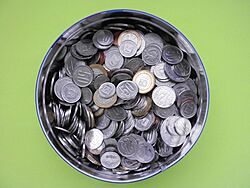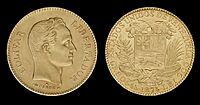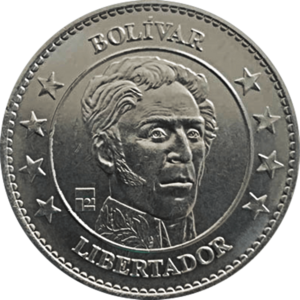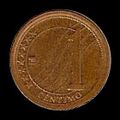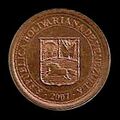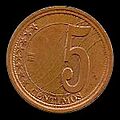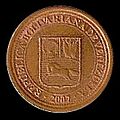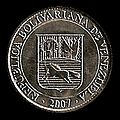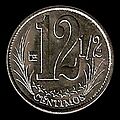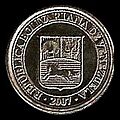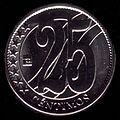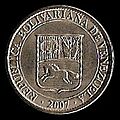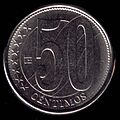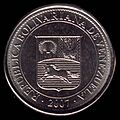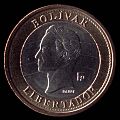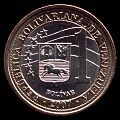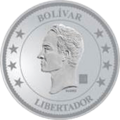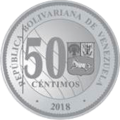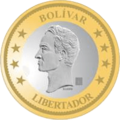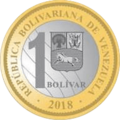Venezuelan bolívar facts for kids
Quick facts for kids Venezuelan bolívar |
|
|---|---|
| ISO 4217 Code | VED |
| User(s) | |
| Inflation | ▼ 114.10% (2022) |
| Subunit | |
| 100⁄{{{2}}} | céntimo |
| Symbol | Bs. |
| Nickname | bolo(s), luca(s), real(es) |
| Plural | bolívares |
| Coins | 25, 50 céntimos, Bs. 1 |
| Banknotes | VED series: Bs. 5, Bs. 10, Bs. 20, Bs. 50, Bs. 100 |
The bolívar is the official money of Venezuela. It is named after Simón Bolívar, a famous hero who helped South American countries become independent. The bolívar was first used in 1879. Before that, Venezuela used a different currency called the venezolano.
For many years, the bolívar was a very stable currency. It was even accepted in other countries. This was because its value was linked to silver and gold, and later to the United States dollar. But in 1964, Venezuela changed its money system. It decided to let the bolívar's value change freely, which is called a floating exchange rate.
Since 1983, the bolívar has faced big problems with inflation. This means that prices go up very quickly, and money loses its value. The bolívar lost a lot of its value against the US dollar. To try and fix this, a new version called the hard bolívar was introduced in 2008. One hard bolívar was worth 1,000 old bolívares.
However, the hard bolívar also struggled with high inflation. From 2016 to 2019, and again in 2020, Venezuela experienced hyperinflation. This is when prices rise extremely fast, making money almost worthless.
Because of this, the money was changed two more times. In 2018, the sovereign bolívar was introduced. One sovereign bolívar was worth 100,000 hard bolívares. Then, in 2021, the digital bolívar was created. One digital bolívar was worth 1,000,000 sovereign bolívares. This means that one digital bolívar is now worth 100,000,000,000,000 (100 trillion) of the original bolívares!
Today, both sovereign and digital bolívares are used. However, many people in Venezuela now use US dollars for most of their buying and selling. Some also use the Colombian peso.
History of the Bolívar
The Original Bolívar
The original bolívar was named after Simón Bolívar, a key figure in South American independence. It was introduced in 1879. At first, its value was based on silver. Later, it was linked to gold.
In 1934, the bolívar's value was set against the US dollar. For a long time, until 1983, the bolívar was known as a very stable currency in the region. But after 1983, it started to lose its value quickly. This day is sometimes called "Black Friday" in Venezuela.
To stop money from leaving the country, the government put in place exchange controls in 2003. This meant the bolívar's value was fixed to the US dollar at a certain rate.
The Hard Bolívar
In 2007, the government announced a big change. They would remove three zeros from the bolívar's value and call it the bolívar fuerte, or hard bolívar. This change happened on January 1, 2008. The idea was to make it easier to handle money and count large amounts.
However, the hard bolívar also faced problems. The government had strict rules about how much foreign money people could get. Despite this, the bolívar kept losing value. The government changed its official value against the US dollar several times. For example, in 2013, it was changed from Bs.F 4.30 to Bs.F 6.30 for every US dollar.
By November 2016, the hard bolívar entered a period of hyperinflation. This meant its value was dropping extremely fast. In 2018, the government stopped the fixed exchange rate. The bolívar lost 99.6% of its value, making it one of the least valuable currencies in the world.
The Sovereign Bolívar
Because of the extreme hyperinflation, another change was needed. On August 20, 2018, the government launched the sovereign bolívar. This time, 100,000 hard bolívares were exchanged for just 1 sovereign bolívar. New coins and banknotes were introduced.
Along with the new money, the government also raised the minimum wage a lot. They also increased sales tax. The sovereign bolívar was also supposed to be linked to a new digital currency called the petro. However, many people doubted if the petro was real or useful.
Even with the new sovereign bolívar, inflation continued to be a huge problem. By October 2021, Venezuela decided to remove six more zeros from its currency.
The Digital Bolívar
The digital bolívar was introduced on October 1, 2021. One digital bolívar was equal to 1,000,000 sovereign bolívares. This change was called the "new monetary expression."
The old sovereign bolívar banknotes were still accepted, but their value was adjusted. For example, a Bs.S 500,000 banknote became worth 0.50 digital bolívares, or 50 céntimos.
For a while, shops had to show prices in both sovereign and digital bolívares. But now, it's more common to see prices listed in "REF," which means "Reference." This refers to prices in US dollars, and customers can pay in digital or sovereign bolívares at the current exchange rate.
Currency Black Market
Venezuela has an unofficial, or "black," market for currency. On this market, the value of the bolívar is much lower than the official rates set by the government. This means that people pay a lot more bolívares to get one US dollar on the black market.
For example, in 2013, one US dollar was worth almost ten times more on the black market than the official rate. This difference grew even larger over the years. By 2017 and 2018, the black market rate for one US dollar reached millions of bolívares.
A website called DolarToday has been publishing these unofficial exchange rates since 2010. The graph below shows how much the bolívar has lost its value against the US dollar on the black market over time.

Coins
Bolívar Coins
When the bolívar was first introduced in 1879, there were silver coins in different values, and even gold coins. Over the years, the materials used for coins changed. Nickel replaced silver, and then steel was used.
In 1998, because of high inflation, new coins were made with higher values, like Bs. 10, Bs. 20, Bs. 50, Bs. 100, and Bs. 500.
All these coins had a similar design. On one side, they showed the left side of Simón Bolívar's face, with the words "Bolívar Libertador." On the other side, they showed the country's coat of arms, with the name of Venezuela, the year, and the coin's value.
Hard Bolívar Coins
Coins for the hard bolívar were made in values like 1, 5, 10, 12½, 25, 50 céntimos, and Bs.F 1. However, these coins quickly became almost worthless because of the very high inflation.
In 2016, new hard bolívar coins were announced for Bs.F 10, Bs.F 50, and Bs.F 100. These were meant to replace banknotes of the same values.
Sovereign Bolívar Coins
Sovereign bolívar coins were planned for 50 céntimos and Bs.S 1. But just like the hard bolívar coins, these also became worthless very quickly due to ongoing hyperinflation.
Digital Bolívar Coins
On October 1, 2021, new coins for the digital bolívar were released. These came in values of 25 and 50 céntimos, and 1 bolívar.
Banknotes
Bolívar Banknotes
The Central Bank of Venezuela started printing paper money in 1940. They issued banknotes in values like Bs. 10, Bs. 20, Bs. 50, Bs. 100, and Bs. 500. Over time, as coins replaced lower values, higher value banknotes were introduced due to inflation.
By 1998, banknotes reached values of Bs. 10,000, Bs. 20,000, and Bs. 50,000. After 2000, some banknotes changed their name from "Banco Central de Venezuela" to "República Bolivariana de Venezuela" to reflect the country's new constitution.
Hard Bolívar Banknotes
New hard bolívar banknotes were issued from 2007, with values from Bs.F 2 to Bs.F 100. These notes were used from 2008 until 2018. The front of these notes featured portraits of important Venezuelan figures, while the back showed animals and their natural habitats.
Because of hyperinflation, the value of these banknotes dropped dramatically. By December 2016, the largest note, Bs.F 100, was only worth about US$0.23 on the black market. The government tried to remove the Bs.F 100 notes from circulation quickly, claiming it was to fight "mafias."
In 2017, even higher value banknotes were introduced, including a Bs.F 100,000 note. But by May 2018, even this high-value note was worth very little. The lower value hard bolívar banknotes were removed from circulation in August 2018, and the higher ones followed in December 2018.
Sovereign Bolívar Banknotes
When the sovereign bolívar was launched in August 2018, new banknotes were introduced. These included values like Bs.S 2, Bs.S 5, Bs.S 10, Bs.S 20, Bs.S 50, Bs.S 100, Bs.S 200, and Bs.S 500. However, within months, many of these notes also became almost worthless due to continued inflation.
By June 2019, even higher denominations were needed, so Bs.S 10,000, Bs.S 20,000, and Bs.S 50,000 notes were printed. The Central Bank said these new notes would help the money system work better. But by December 2020, the highest note (Bs.S 50,000) was worth less than US$0.05.
In March 2021, three more new banknotes were introduced: Bs.S 200,000, Bs.S 500,000, and Bs.S 1,000,000. At the time, the Bs.S 1,000,000 note was only worth about US$0.52.
Digital Bolívar Banknotes
In 2021, new banknotes for the digital bolívar were introduced. These notes come in values of 5, 10, 20, 50, and 100 bolívares. They all have similar designs but different colors.
Images for kids
| Current VED exchange rates | |
|---|---|
| From Google Finance: | AUD CAD CHF EUR GBP HKD JPY USD INR EUR JPY |
| From Yahoo! Finance: | AUD CAD CHF EUR GBP HKD JPY USD INR EUR JPY |
| From XE.com: | AUD CAD CHF EUR GBP HKD JPY USD INR EUR JPY |
| From OANDA: | AUD CAD CHF EUR GBP HKD JPY USD INR EUR JPY |
| From fxtop.com: | AUD CAD CHF EUR GBP HKD JPY USD INR EUR JPY |


